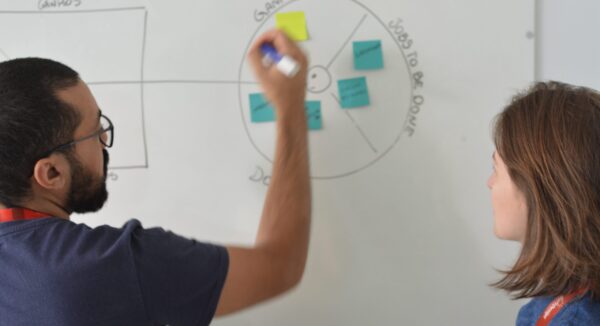
- Digital Transformation
AI-powered modernization is the strategic use of Artificial Intelligence to accelerate legacy system transformation, automate processes, and continuously generate business value. In practice, with AI support, squads gain greater agility and autonomy to extract intelligence from historical data, accelerate time to market, and replace legacy systems in a way that is more aligned with business demands.
In today’s rapidly evolving competitive landscape—and with the fast rise of AI—modernization has become an urgent priority. However, updating legacy systems remains a complex challenge. In this context, AI helps overcome these hurdles with greater depth and lower risk, accelerating the understanding of existing systems, freeing time for more strategic decisions, and driving improvements in speed and quality.
According to Gartner, 50% of CEOs are prioritizing integration, innovation, and modernization of enterprise applications and software by 2025. In large organizations, where legacy systems support critical operations, the challenge lies in innovating without compromising stability. A difficult but essential step for digital transformation.
In this article, we explore how AI-powered modernization enables organizations to integrate analytics, automation, and intelligent decision-making without requiring disruptive system rebuilds.
Companies are undergoing a paradigm shift: we’ve moved past the digitalization phase—focused on migrating processes to digital—and entered the era of intelligent automation, powered by Artificial Intelligence. This new phase demands speed, scalability, and the ability to innovate consistently.
In this context, modernizing legacy systems is no longer a technical choice, but a strategic necessity. Outdated technologies bring risks due to lack of vendor support and qualified professionals, fail to meet user expectations, increase infrastructure costs, and hinder the adoption of innovations such as cloud, AI, and third-party APIs.
Legacy code also directly impacts scalability and the speed of delivering new features. When applied to modernization efforts, Artificial Intelligence reduces manual effort and significantly accelerates the software delivery lifecycle.
At SoftDesign, we leverage AI to accelerate deliveries across multiple fronts. On the back end, unit test generation is automated: developers only need to name the test, and Copilot completes the implementation based on context. We also migrate legacy code to modern standards, ensure compliance with architectural patterns, and accelerate scaffolding by automatically creating repositories, services, and endpoints.
On the front end, Copilot assists in generating models and services from Swagger documentation, while also providing contextual suggestions for building interfaces with reusable components. In Quality Assurance, AI automatically generates end-to-end test cases with Cypress, increasing test coverage with less manual effort.
For business leaders, this is a critical moment: digital transformation with AI is a matter of survival in increasingly dynamic markets. Organizations driving this modernization with AI-augmented squads release products faster, improve delivery quality, and reduce project costs.
According to Red Hat’s The State of Application Modernization report, 78% of organizations are using AI as part of their modernization efforts. Among them, 53% use AI to support application modernization processes, while 42% are adding AI to legacy systems to update them.
At SoftDesign, we apply intelligent automation and advanced software engineering to modernize systems in a secure and effective way. Our process directly impacts speed, quality, and alignment with business strategy.
Key benefits of AI-powered modernization include:
As shown, AI-powered modernization is already driving change across corporate environments. Some practical examples include:
At SoftDesign, modernization involves applying AI strategically across every stage of the SDLC. In practice, we use Artificial Intelligence from prototyping and data analysis to MVP creation with low-code tools.
Our AI agents also assist in backlog writing and prioritization, legacy code analysis, assisted coding, code review and refactoring, and automated test generation.
A successful AI-powered modernization strategy requires structured planning and alignment with business goals. At SoftDesign, we execute this process in three main phases:
Discovery to understand business vision and existing processes;
Technical approach and architecture definition;
Roadmap creation and initial estimates.
Lean development focused on value;
Use of the Strangler pattern to run alongside legacy systems and gradually replace them;
AI acceleration: automatic code generation, intelligent testing, scaffolding, and copilots.
Ongoing flow with Kanban;
Incremental deliveries with progressive decommissioning of legacy systems;
Expanding AI coverage across development, QA, and operations;
Performance monitoring, data-driven adjustments, and adoption of new AI capabilities.
Spring Point, a U.S.-based company specializing in software for the electromechanical industry, modernized its legacy ERP system MotorBase—originally built in the 1990s with a client–server architecture. With SoftDesign’s support, the company developed the first version (MVP) of a new cloud-based SaaS solution, redesigned with a user experience–driven interface.
According to Troy D. Locke, CEO and co-founder of Spring Point Solutions, integrating AI into software is highly strategic to improve predictability and optimize client operations. SoftDesign’s partnership drives this evolution through testing and experimentation with intelligent features.
“SoftDesign shows us exactly how the team is already using AI to reduce coding time, with concrete examples that give us confidence we’re on the right path. This not only improves code but also workflows and our understanding of technology,” shares Troy.
Implementing Artificial Intelligence brings significant opportunities, but also requires attention to critical challenges to ensure sustainable and ethical results:
The adoption of AI in modernization must generate measurable impact. Some key metrics to track ROI include:
At SoftDesign, we transform legacy systems into modern platforms by combining intelligent automation with cutting-edge software engineering. By embedding AI into every stage of development, we accelerate coding by up to 60%, automate tests with wide coverage, and deliver scalable solutions with excellence in UX, cloud, and architecture.
AI-powered modernization is a strategic path for companies seeking agility, efficiency, and continuous innovation. By combining intelligent automation, integration with legacy systems, and skilled teams, organizations can cut costs, accelerate time to market, and significantly increase productivity.
SoftDesign is a global software development company that combines design, strategy, and Artificial Intelligence to build impactful digital products. We integrate AI agents across our entire SDLC, boosting squad productivity by up to 55%.
If you’re ready to take the first steps in an AI-powered modernization plan, count on our expertise in app development, platforms, data solutions, intelligent agents, and Machine Learning models.
SoftDesign has the expertise to help your organization achieve digital transformation with tailored solutions and proven results. Get in touch with us and begin your digital transformation journey with the right partner.
AI-powered modernization is the use of Artificial Intelligence to update processes, systems, and technologies, making them more efficient, intelligent, and automated.
Traditional modernization focuses on updating technology, while AI-powered modernization also integrates Artificial Intelligence for automation, predictive analysis, and intelligent decision-making.
AI-powered application modernization improves efficiency and quality in processes, enhances user experience, and enables faster, more accurate, data-driven decisions.

